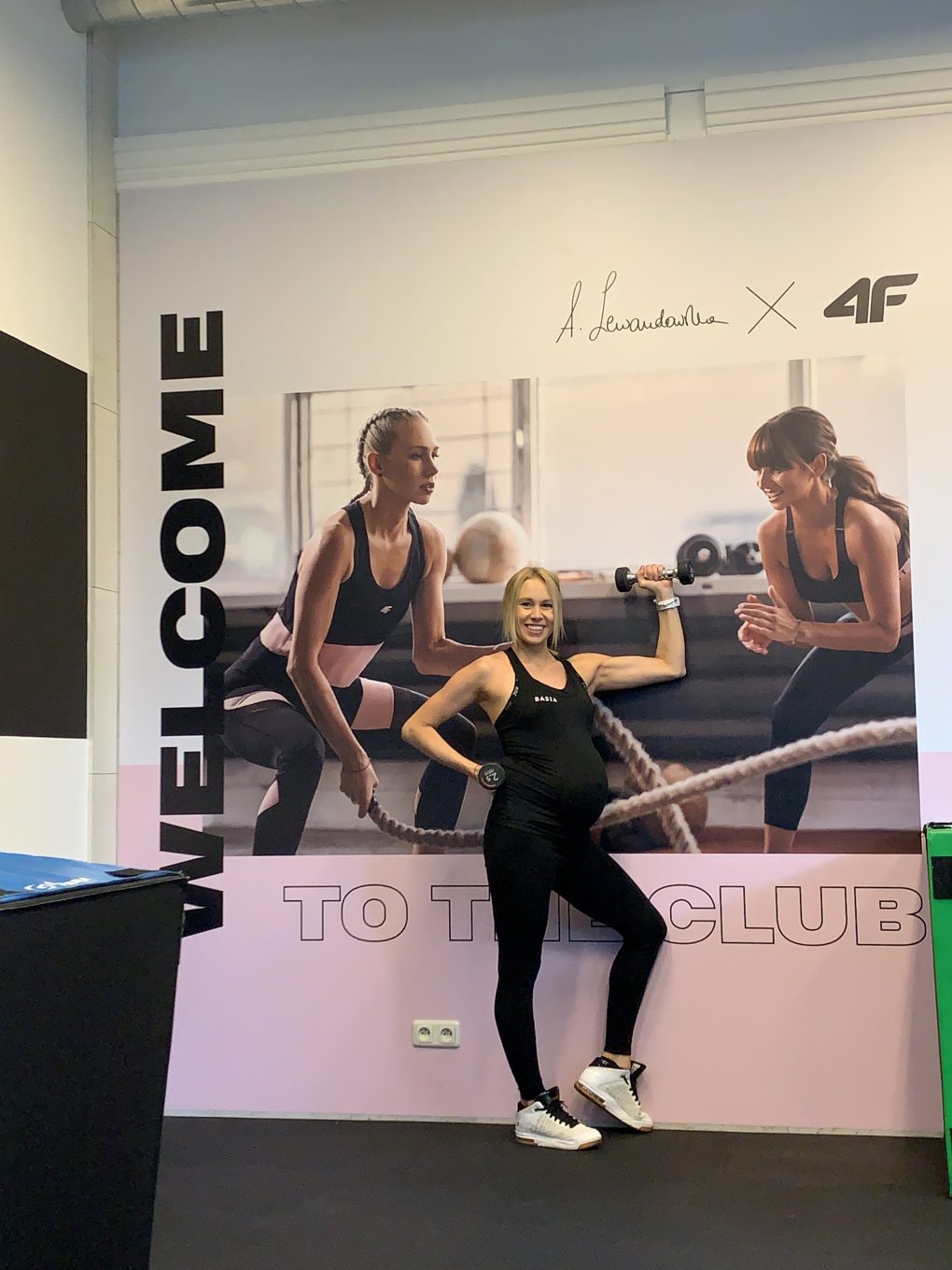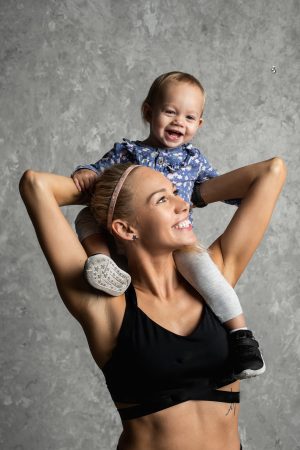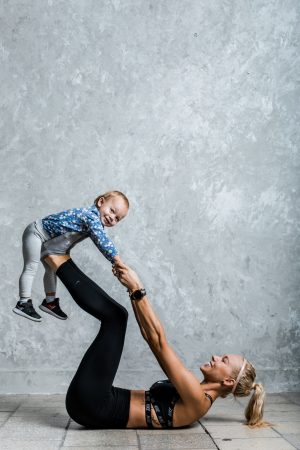
THE ROAD TO HEALTH: Pregnant Once, Always Postpartum. B. Smirnow-Kurp
Today I have an article written particularly for mothers – moms-to-be and those who have just given birth. ? Today we have another post in the series “The Road to Health. Did you know that …?” in which Basia Smirnow-Kurp writes about very important aspects that each woman should pay attention to when planning pregnancy. Enjoy!
We live in a time when we carefully collect photos documenting pregnancies on social networks. The photos are beautiful, majestic, full of joy and expectations. Young mothers are counting down the days to childbirth, and the happy ones pose with their growing belly. Then they publish a photo with the baby after childbirth and the main character – the Mother… disappears. The profile is flooded with a collection devoted to the newborn baby. And what is happening to the woman?
It is sad that what happens to a woman’s body after pregnancy is subject to social pressure that is so strong that it does not even need to be articulated. The rules are clear: as a pregnant woman you can’t gain too much weight, after giving birth you should lose those kilograms as soon as possible, and when you are tired and exhausted, just don’t go out into the world! A classic Polish mother has to be in love with the newborn baby, shouldn’t think about her health but wonder how to return to a fit body as soon as possible and then all the standards of… others around us are met. Nobody thinks about how the course of the pregnancy or what the birth was like because social media profiles create another reality, you always show your world with a smile on your relaxed face. We are a bit guilty of it ourselves, you have to be honest and true in everything and then we won’t become prisoners of our own product.
Why is my body so different from the one I used to live in? Why does pregnancy change so much, after all, I came back to my weight and I still don’t fit into my jeans? Why do I look so “different”? After my first pregnancy, everything went perfectly as planned, and after my second baby, I feel as if I’ve been living in another person’s body.
Start over again
Let’s start with the fact that each time it’s different from what it was before. And this applies to everything in our lives 🙂 During pregnancy, a woman’s posture changes. As the belly grows, the center of gravity shifts forward. If the muscles on the back of the leg were in good shape, their strength would balance this displacement. But due to our sedentary lifestyle, the calf muscles and biceps of thigh are usually shortened and tense, so the body looks for other strategies to compensate for the shift in the center of gravity. The growing belly makes it difficult for the diaphragm to work, and a common strategy to deal with this is to push the ribs and chest forward. We walk around for the next few months, and our body begins to treat this position as natural. The way you use your body, from the positioning of your feet to the range of motion in your shoulders, affects how pressure is distributed within your torso. If this has not been “fixed” after the first pregnancy, it is likely that after the second pregnancy the posture will become even more dysfunctional. We don’t notice it when we look at ourselves in the mirror, if we have time for it. This happens gradually as you repeat your daily activities.
The entire pregnancy is 10 lunar months long. And the changes that are taking place in your body are happening all the time. It’s not like we get pregnant and the belly is large right away, the baby is fully developed and the muscles are stretched and relaxed. It happens gradually. There are many phenomena aimed at gaining space for a developing fetus and facilitating childbirth. You can read a lot about a quick return to a fit body, but I don’t think anyone believes that the process that was developing for 9 months will reverse within only 6 weeks of puerperium, and from then on we can start living as before pregnancy.
The course of pregnancy, delivery and the so-called 4th trimester, i.e. puerperium, are of great importance.
I am a physiotherapist. Does it help me when I look at my posture in the mirror? Not at all, because I get used to my new body, but it helps to be aware of the correct habits, such as lifting the baby the right way, knowing how to get out of bed, how to use the toilet and doing pelvic floor exercises.
At work I always ask the patient about her birth history, regardless of the age of her children. No matter if she’s just become a mother or if it’s been many years since the last labor. All these stories matter. As Elizabeth Banks said in the movie “What To Expect When You Expect” “(…) Human creation is really hard”! Your body is going through so many changes. So many.
Changes and even more changes
It’s not a popular thing to say that childbirth also means the birth of a mother and is one of the most extreme experiences for the human body. The results of one of the recent studies surprised even its authors – magnetic resonance imaging (RMI) carried out among women from the risk group, i.e. those in whom bearing down lasted particularly long, showed that many of them still had visible damage to soft structures, i.e. ligaments, muscles, a year after labor. For a small percentage (about 3%) of women, childbirth was such a traumatic experience that they developed post-traumatic stress disorder. So maybe it is worth moving the narrative from a perfectly flat belly to the really important issues in the discussion about getting back into shape? Because now the awareness is that a woman recovers after giving birth within 6 weeks and at the end of the puerperium everything returns to the state before pregnancy. There is, of course, a group of women who will generally not feel any major perturbations, but those who do have the right to know that they are not the only ones. And above all, that they have the right to longer recovery. And that sometimes they will need professional help and rehabilitation, for example, of the pelvic floor muscles. Although I think that every woman after childbirth should visit a physiotherapist and examine herself from the inside, like a car inspection after an accident ? Because the price women pay for having a baby is sometimes surprisingly high. And we focus on the appearance of the mother’s bellies … that’s so sad.

There is still so much room for improvement in the health system. Let’s compare something. If you had, for example, arthroscopic reconstruction of the knee ligament, you would probably be referred for rehabilitation once or twice a week after the surgery, and maybe even more often depending on your goals … yeah, they ask (before surgery) what your goals are and if you want to stay active as this helps in the application of the ligament transplant form. Rehabilitation will include a full functional assessment by a physical therapist and a progressive treatment plan with home exercises to restore strength and function of all muscles involved. Thank God you have guidance and rehabilitation for that, right? What if the surgeon woke you up after the operation and said, “Time to get up, your body should heal itself.” No way, you are always under the supervision of your attending physician to get you back on track.
And now let’s have a look at the delivery room. Does anyone ask about the birth plan? Even if it is prepared, hardly anyone respects it. Does anyone ask if you want to run, jump with your child on the trampoline? Hardly ever … We give birth because it is in our nature, what about our physical, not to mention emotional, changes? Our health service has ignored the importance of caring for mom after she has had a baby. Almost 10 months of creating and carrying a human, and after birth, little attention is paid to mum’s recovery, unless “significant” trauma is noted. And yet we decide to have another pregnancy, another “creation” of an ideal being. We forget about the pain, we forget about ourselves, we devote ourselves completely to the exceptional phenomenon of pregnancy and motherhood.
Second Pregnancy, second labor and another postnatal period
Does the body get back into shape in the same way? Well, absolutely not, not necessarily.
As a young mother after the second birth, I can say from my own experience that the second pregnancy and recovery is a completely different way. Everything is different, because we are different. Our body has “memory” and is a master at adaptation … and unfortunately this adaptation is not always the one we would like to go through.
What seems obvious at first sight, does not always reflect what is happening under the skin, ie, “don’t judge a book by its cover”. When you are pregnant again, muscle tissue grows faster and the cartilage tissue loosens along with the loosening of the cartilage, which in the pelvic and abdominal cavity allows for the hypertrophy of the uterus, its ligaments and abdominal integuments, stretching the diaphragm and moving the pelvic bones.
When we delving a bit into the anatomy and biomechanics of our body, we see that there are three culprits: muscles, fascia, and the bones and joints. One of the most important and noticeable changes in a woman’s body during pregnancy are changes in the musculoskeletal system, including changes in the myofascial system and changes in the osteoarticular system.
The accumulated weight gain in the pelvic area is the main factor causing mechanical changes in the pregnant woman’s body. These include: pelvic anterior tilt, flexion contractures of the hip joints and lumbar hyperlordosis. They are designed to compensate for the body imbalance caused by the advancement of the uterus and enlarged breasts, which makes the woman assume a very upright posture. Such an attitude causes the center of gravity to shift 2 cm forward, which in turn often results in increased tension of the short muscles of the spine in the lumbosacral region. That is why it is so important to rehabilitate the body after each pregnancy to compensate for these inevitable shifts. The resulting changes will not return to their pre-pregnancy state by themselves, we need to help the body.
Early pregnancy adaptation also causes changes in the appearance of the chest, which probably occur as a result of the loosening of the intercostal attachments. The intercostal angle increases from about 70% to 100%, the transverse dimension of the chest increases by about 2 cm, and its circumference by about 5 – 7 cm. Another very important change as the pregnancy progresses, caused by the enlargement of the uterus, is the elevation of the diaphragm (on average by 4 cm), the mobility of which is not impaired, but it reduces the total lung capacity by about 5%. To compensate for this loss of space for respiratory movements, the tissues are stretched, and especially the muscle tone is stopped.
In the 6th – 7th month of pregnancy, under the influence of hormones, the “stretching” phase occurs, noticeable mainly within the abdominal wall. The rectus abdominals are elongated up to 15 cm, which exposes the innate areas of reduced strength (the white line, the umbilical ring and the inguinal ring, and above all the border area from the upper to the middle third of the distance between the navel and the pubic symphysis in the midline) overstretching or even tearing. A great risk is also posed by the divergence of the left and right halves of the abdominal wall in relation to the midline, i.e. the divergence of the straight muscles. This may result in the relaxation of the intestinal block and the disturbance of normal body statics. On the other hand, in the second pregnancy, these changes are noticeable about 1.5 – 2 months faster, which means that we function longer in such “stretching” and adapt to changes. The body no longer fights, because it has memory and adapts much faster to changes also in the bone and joint system. So the circumference of the hips, chest and often feet increases. And we can do nothing about it. It often stays with us forever …
These changes are most noticeable in the area of the pubic symphysis. As pregnancy progresses, cartilage and bone become softer due to excessive accumulation of water and it becomes susceptible to stretching, thanks to which it becomes possible to widen the pelvis laterally by several centimeters. Gaining this small amount of space is extremely important in the case of a constricted pelvis during natural labor. The cartilaginous plaques of the sacroiliac joints and their ligaments are also loosened and stretched. If the pubic symphysis is overstretched (diverged), significant pain may appear, which is often mistaken for abdominal pain.
Changes also occur within the spine – the intervertebral discs are softened, the intervertebral ligaments are also excessively loosened and lose flexibility, which often causes incorrect posture and, consequently, severe, chronic pain symptoms, especially in the lumbosacral section, and hyperlordosis. In this case, rehabilitation is very important so that the posture with pelvic tilt doesn’t become permanent.
All these changes are completely natural and result from the physiology of the human body, even if they often result in painful symptoms. For this reason, pregnancy should not be treated as a disease, but as a very special period in a woman’s life, in which special attention should be paid not only to the development and safety of the fetus, but also to the proper care of the future mother’s body.

Every mom is beautiful!
A mother’s body – this topic is never boring and often comes back, stirring heated debates on websites every time a famous woman becomes pregnant. And it constantly amazes me. Do you know why? Not by creating unrealistic standards of appearance after childbirth for most ordinary women. Honestly, I don’t care if someone has a six-pack on their stomach 3 weeks after giving birth or will never get it back – the variety is great.
What makes me sad is that we completely ignore what is most important, though invisible at first sight. It is what happens to the mother’s body inside. I’m sad we don’t talk about how long it takes the body to recover after birth, or that it sometimes never comes back to the previous shape.
We do not speak about it because we are ashamed. Because it’s hard to admit to the world. So we cry in the bathroom because we are not able to take care of physiological needs without pain, fear or mental block. Anyway, the problem concerns not only what happens immediately after giving birth, but also what we experience months or years afterwards.
Don’t judge – appreciate instead! Because we never know what kind of story we’re dealing with. Let’s love our new body because it’s the only place we really live in.
So please do not go crazy, if you do not fit into your favorite pants, your pelvis has grown a little bit so that your baby can safely appear in the world. Do not be nervous when your favorite bra is pressing, the ribs have increased their angle so that you can breathe during pregnancy. And do not scream in the shopping frenzy that the store has the wrong size of shoes, because you always wore size 38, the size of your foot has changed by loosening the ligaments so that you could get better stabilization in pregnancy. You see, we don’t control everything, but it makes us so unique, different.
Your body will always both remind you of what special time it was and how much your body has gone through. It is not the weight or a flat stomach that matter after pregnancy, but accepting yourself in the current version and coming to terms with the fact that your body is shaped like a mother from now on.
And remember: “Saying: losing excess weight is simple – just eat less and exercise more, is like talking, that being a stockbroker is simple – buy cheap, sell high” Yoni Freedhoff

Bibliography:
- Gunther H., Kohlrauch W. Teirich – Leube H. „Gimnastyka w ginekologii i położnictwie”, Państwowy Zakład Wydawnictw Lekarskich, Warszawa 1974, 207.
- Fenwick E.: „The complete book of Mother & Baby Care” Dorling Kindersley Limited, London 1990, 256.
- Roszkowski I. „Zdrowie kobiety”, Państwowy Zakład Wydawnictw Lekarskich, Warszawa 1981, 351.
- Bień A. M. „Opieka nad kobietą ciężarną”, Państwowy Zakład Wydawnictw Lekarskich, Warszawa 2009, 368.
- Buczek S. „Ciążowe dolegliwości – sposoby zapobiegania”, Medycyna Rodzinna 2009; (2): 39-43.
- Brown i wsp. “Physical health problems after childbirth and maternal depression at six to seven months postpartum” Listening to Mothers III New Mothers Speak Out, 2013.
- Childbirth an athletic event? Sports medicine used to diagnose injuries caused by deliveries. University of Michigan, 201.










Comments No Comments
Join the discussion…